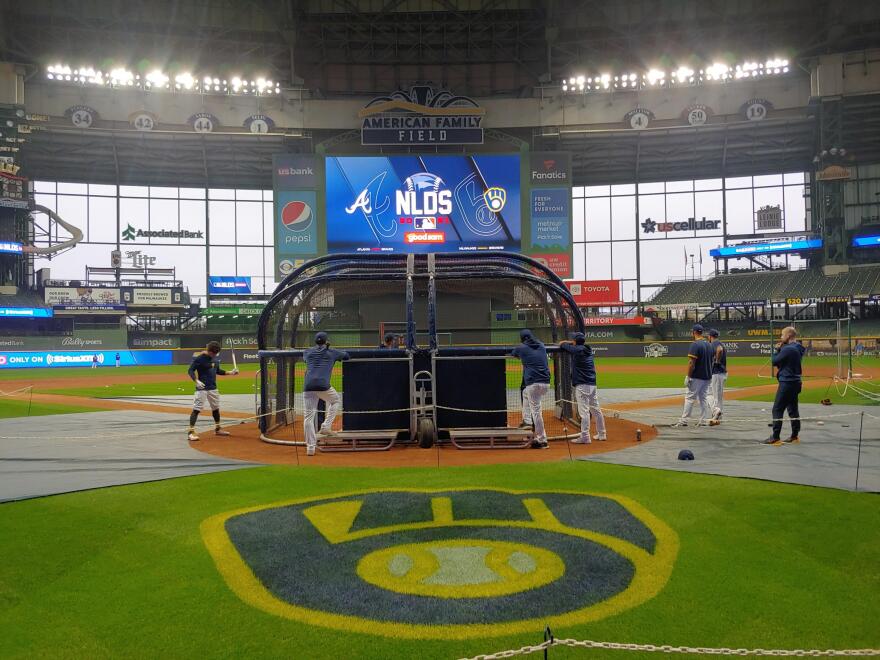The Milwaukee Brewers begin their National League playoff series Friday afternoon against the Atlanta Braves.
Corbin Burnes is expected on the mound for the home team at American Family Field, one of several Brewers pitchers whose skills have caught the eye of a Milwaukee physics professor.
This season, Burnes led the National League in earned run average and was third in strikeouts. On Aug. 11, he even tied a Major League record by striking out 10 consecutive batters.
Burnes has excelled at using a variety of pitches, including a fastball and what are known as breaking pitches — curveballs, sliders, sinkers, and cutters that dip or bend as they near the plate.

For an explanation of how Burnes and the other fine pitchers on the Brewers' roster work their magic, we turned to Jax Sanders, a physics professor at Marquette University and baseball fan.
Sanders said a lot has to do with how a spinning baseball moves, including a force called the Magnus effect.
"The Magnus effect is entirely due to the interaction between a spinning object and air," Sanders said. "When you're talking about the spin on a baseball pitch, that's what gives what the baseball player might call the action — the ability of the ball to move in the air."
Sanders said there are different ways to spin a ball. For example, a common fastball, the four-seamer, has a backspin that makes the ball appear to rise.
"The air is going to be pushed down by this ball, and because it's pushed down, the ball is pushed up. Now, because we live in a world where there is this relatively constant gravity, we kind of expect things to fall at a constant rate. So, what you might perceive as a rising action, it's still falling, just slightly slower than expected," Sanders said.
The Marquette professor said when it comes to Burnes or others throwing breaking balls, the goal is to tilt the spin.
"So, by altering the direction the ball is spinning, you're able to change the direction of that force," Sanders said. "So, for example, with the very classic curveball, you are altering that spin direction so that it's pushing the ball to the side."
Sanders said other breaking pitches have more topspin, to make the ball dive more dramatically.
The professor said Burnes is able to put a lot of spin on a baseball, increasing the force and movement and giving batters less chance of making solid, or any, contact.
"Yes, maybe I'm only moving this ball, on average, one to three inches further than an average pitcher. However, a baseball bat only has a three-inch cross-section," Sanders said.

During a Brewers workout this week, we asked Burnes if he focuses on spin rates when preparing for a game.
"When I'm getting ready for a start, it's all about scouting reports and what I can do to best use my stuff," Burnes said.
But Burnes added that spin rates and other analytic measurements are becoming more common around the league and can help young pitchers who are struggling.
He said his success over the last couple of years stems from figuring out what he wants to do on the mound and improving his pitching motion or mechanics.
"If I do something mechanically that happens to get a little bit more out of it, great. If not, it's all about what I want to do, to attack hitters," Burnes said.

Brewers outfielder Jackie Bradley, Jr. said hitting against the spin rate artists is a challenge.
"The best in the world. I mean, it's a difficult game. That's why there's not that many players up here, because you're at the top," Bradley said.
First baseman Rowdy Tellez said trying to deal with some of these spinning pitches is why he agrees with the longtime saying that the hardest thing to do in sports is hit a baseball.
But Tellez said hitters do gain experience.
"When you've been doing it for a while, you start to get the hang of it and notice it," Tellez said. "We've been doing it at a high level for a long time, and you get used to it."
Tellez said when baseball cracked down this year on the use of foreign substances that would give pitchers a better grip on the ball and potentially help increase things like spin rate — some pitchers went old school and focused on better technique.
Tellez said, as a hitter,"you just kind of gotta roll with the punches."
And the team that does the better job of that, the Brewers or the Atlanta Braves, will win the best of five National League Division Series and rise into the next round of the baseball playoffs.






